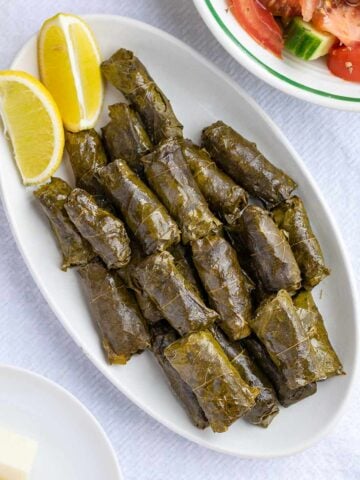Greek recipe for homemade tzatziki sauce with all the right tips to make it thick and creamy plus two more easy tzatziki variations with carrot and beetroot!
Can be served as a dip or a healthy side to many dishes!

Step aside hummus, it's time for homemade tzatziki sauce!
Greek tzatziki is probably the most famous Greek sauce and it's inextricably linked with gyro (probably the only place in Greece where they don't add tzatziki to gyro is Crete, where they add plain yogurt instead).
Tzatziki is a healthy yogurt-based sauce with grated cucumber and minced garlic. Though you can use it as a sauce for many dishes, it can also be served as a dip with fresh vegetable sticks, pita bread or these extra crunchy zucchini chips. Another option is to spread it on your sandwiches!
The only thing that may differ from tzatziki recipe to tzatziki recipe is the amount of garlic used, something that depends on everyone's taste. I suggest starting with a small amount of garlic (1 garlic clove per cup of yogurt) and adding more after tasting it.
For a simpler variation of this recipe you can also try this Greek yogurt dip for veggies, chips and more.

In this post you will find the authentic recipe with cucumber and another two variations, one with grated carrot and another one with grated beetroot. All of them are easy and delicious and they can be enjoyed just with a piece of bread or even as an ingredient for this cheese board-platter.
Also, in this Greek pork skewers recipe you will find another variation with black garlic.
Fun fact: According to wikipedia tzatziki can be a sauce, a dip or even a soup and according to tasteatlas.com there are many regional variations of tzatziki in countries such as Iran, Iraq, Turkey, Cyprus, Bulgaria, and Serbia.
Ingredients
Tzatziki is a simple and easy recipe with just a few, common ingredients:
- Greek strained yogurt (preferably from whole milk)
- Grated cucumber (Persian cucumbers work best, plus you don't have to peel them)
- Minced garlic
- White wine vinegar (I prefer apple cider vinegar)
- Olive oil
- Salt and pepper
- Chopped dill weed (almost every Greek recipe has it, but you can skip it if you hate dill).
Variations
Carrot tzatziki recipe
In this recipe the cucumber is replaced with the same amount of grated carrot and half a teaspoon of ground cumin.
Cumin pairs very well with the sweetness of the carrot and the end result is very interesting and delicious. For a milder garlic taste I prefer to use dried garlic powder.
Beetroot tzatziki
In this recipe the cucumber is replaced with the same amount of grated beetroot. I generally don't like the taste of beetroot but when it's combined with dairy it's transformed into something else so even if you also don't like beetroot I suggest giving it a try.
The addition of chopped capers gives this sauce delicious bursts of flavor so I highly recommend it! If you can't find capers maybe you can add some sliced olives or chopped pickles.

Useful Tips
Are you wondering why your tzatziki sauce is watery? It's because it has more moisture than it should. How can you avoid that? Follow these simple steps to achieve thick and creamy tzatziki every time:
- Choose a thick, full fat Greek strained yogurt. Don't be afraid of full fat Greek yogurt because it still has about 5% fat which is pretty low.
- Not all Greek yogurts are created equal. If your yogurt is not VERY thick, you should transfer it to a cheesecloth or kitchen towel and strain it for a few hours or overnight. The procedure is the same as making homemade Labneh (just watch the short video in this how to make Labneh article!)
- Grate the cucumber (or the carrot or the beetroot) and transfer it to a cheesecloth and squeeze hard to get rid off the extra moisture. Adding a little bit of salt helps to extract the moisture. If you're bored to do this, at least squeeze it hard between your hands!
- Mix all of the ingredients together in a bowl. Taste and add more salt or garlic if needed (keep in mind that the garlic taste will become stronger with time). Store in the fridge for a few hours to let the flavors develop.
Serving suggestions
Tzatziki is almost always served as an appetizer or meze and it's the perfect sauce, especially if you plan to host an International Dinner at Home!
You can also use it as a spread for sandwiches, a sauce for cooked meats, as a salad dressing or you could slather it onto sandwiches or pita wraps. Dishes that pair well with tzatziki are:
- Spanakopita
- Souvlaki
- Gyros
- Stuffed vine leaves (Dolmades)
- Vegetable sticks, bread or crackers
- French fries
- Pita bread
- Dishes containing rice
- Falafel

What can I use instead of tzatziki?
The following dairy based ingredients have a (somewhat) similar flavor profile:
- Plain Greek strained yogurt with a pinch of salt
- Greek yogurt mixed with some dried garlic powder
- Spicy feta cheese dip (tirokafteri)
- Labneh or cream cheese
- Sour cream
You can also try these non-Dairy condiments but they have a different flavor profile. However, they'll add creaminess and flavor to your dishes:
🎥Recipe Video
📖 Recipe

Tzatziki Sauce (classic + 2 variations)
Ingredients
Classic recipe:
- 1 small cucumber, grated (about half a cup / 125 grams)
- 1 cup (250 grams) Greek strained yogurt (the thicker the better)
- 2 teaspoons apple cider vinegar (or white wine vinegar)
- 2 teaspoons e.v. olive oil
- 1-2 tablespoons dill weed, chopped
- 1 minced garlic clove
- salt and freshly grated black pepper to taste
Instructions
- Strain the yogurt (optional). See notes for how to do that.
- Grate the cucumber through the large holes of a box grater and transfer it to a cheesecloth. Squeeze hard to get rid off the extra moisture (adding a little bit of salt helps to extract the moisture).If you're bored to do this, at least squeeze it hard between your hands!
- Mix all of the ingredients together in a bowl. Taste and add more salt, vinegar or garlic if needed (keep in mind that the garlic taste will become stronger with time).
- Store in the fridge for a few hours to let the flavors mature and develop.Serve.
Notes
For the carrot tzatziki:
Replace the cucumber with ½ a cup of grated carrot (best to squeez out the extra liquid) and replace the raw garlic with ½ teaspoon dried garlic powder. Also add ½ teaspoon ground cumin.For the beetroot tzatziki:
Replace the cucumber with ½ cup of grated beetroot (best to squeez out the extra liquid). Also add 1-2 tablespoon chopped capers. .- Whole milk yogurt works best for this recipe.
- If your yogurt is not very thick, transfer it to a cheesecloth or kitchen towel and strain it for a few hours or overnight. The procedure is the same as making homemade Labneh (just watch the short video in this how to make Labneh article) Use 1 ½ cups of yogurt if you plan to strain it, because it will reduce in volume.
- Tzatziki will last in the fridge for at least 4-5 days. Double the recipe if you want more.
- Some people like tzatziki with very intense garlic flavor and others with very mild. I suggest you start with 1 garlic clove per cup of yogurt. If you like a very mild flavor you can use half garlic clove. If you prefer a strong garlic flavor you can use 2 garlic cloves per cup of yogurt.
- For all the variations you can replace the raw garlic with 1 teaspoon dried garlic powder for milder taste.
- If you don't like dill you can replace it with fresh mint or parsley (or just omit it).





Efi says
Squeezing the cucumbers makes all the difference.
Great recipe
Makos says
Thanks Efi!